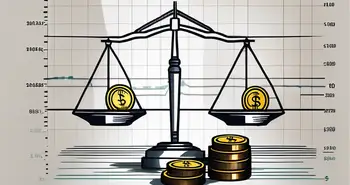The Power of Quantitative Trading: Unleashing Profit Potential

Quantitative trading is revolutionizing the financial world, allowing investors to tap into unprecedented profit potential. As an expert in this field, I have witnessed firsthand the incredible advantages that quantitative trading offers. In this article, I will delve into the intricacies of this powerful approach, explore the role of technology, highlight its benefits, discuss the challenges it presents, and provide insights into its future. Join me as we unlock the secrets of quantitative trading and discover how it can transform your investment strategies.
Understanding Quantitative Trading
At its core, quantitative trading is a data-driven approach that relies on mathematical models and statistical analysis to make investment decisions. By using algorithms to identify patterns and predict market movements, quantitative traders can capitalize on opportunities that traditional traders are likely to miss. This systematic approach eliminates emotional biases and maximizes the potential for profits.
Quantitative trading is a fascinating field that combines the power of data analysis, mathematics, and finance. It offers a unique perspective on the financial markets, allowing traders to uncover hidden patterns and exploit them for financial gain. Let's delve deeper into the basics of quantitative trading to gain a better understanding of its inner workings.
The Basics of Quantitative Trading
To grasp the basics of quantitative trading, you must first understand the fundamental concepts of statistics and finance. It involves analyzing vast amounts of historical data, identifying patterns, and developing strategies based on these insights. These strategies are then deployed in real-time to execute trades automatically, often at lightning-fast speeds.
Imagine being able to process huge volumes of market data in seconds, spotting profitable trends, and executing trades with precision and speed. This is the power of quantitative trading. By harnessing the capabilities of advanced technology and sophisticated algorithms, quantitative traders gain a significant edge in the financial markets.
Quantitative trading strategies can be categorized into various types, such as trend-following, mean-reversion, statistical arbitrage, and machine learning-based approaches. Each strategy aims to exploit specific market inefficiencies or patterns, providing opportunities for profit.
Key Components of Quantitative Trading
Quantitative trading encompasses various key components that work in tandem to drive successful outcomes. These components include data collection and analysis, model creation, backtesting, optimization, and execution. Each step plays a crucial role in building a robust and profitable quantitative trading strategy.
Data collection and analysis form the foundation of quantitative trading. Traders gather vast amounts of historical market data, including price movements, volume, and other relevant variables. This data is then meticulously analyzed to identify patterns, correlations, and anomalies that can be exploited for profit.
Once the data has been analyzed, traders create mathematical models that capture the underlying dynamics of the financial markets. These models can range from simple statistical models to complex machine learning algorithms. The goal is to develop a model that accurately predicts future market movements based on historical patterns.
Before deploying a trading strategy in the live market, it is crucial to test its performance using historical data. This process, known as backtesting, evaluates the strategy's profitability and risk characteristics. Backtesting helps traders understand how the strategy would have performed in the past and provides insights into its potential future performance.
Optimization is another critical step in quantitative trading. Traders fine-tune their strategies by adjusting various parameters to maximize profitability and minimize risk. This iterative process involves testing different combinations of parameters and selecting the ones that yield the best results.
Finally, the strategies are executed in real-time using advanced technology and infrastructure. Quantitative traders rely on high-speed trading platforms and low-latency connections to execute trades swiftly and efficiently. The ability to execute trades in milliseconds can make a significant difference in capturing profitable opportunities.
Quantitative trading is a dynamic and ever-evolving field. Traders continuously refine their strategies, adapt to changing market conditions, and incorporate new data sources and techniques. The quest for profitable trading strategies drives innovation and pushes the boundaries of what is possible in the financial markets.
The Role of Technology in Quantitative Trading
In the world of quantitative trading, technology is the driving force behind its success. With the advent of algorithmic trading, computers can execute trades with incredible speed and accuracy, eliminating human error and inefficiencies.
But what exactly is algorithmic trading and how does it impact the financial industry? Algorithmic trading, a subset of quantitative trading, involves the use of pre-programmed instructions to automatically execute trades based on specific criteria, such as price, volume, or timing. This approach allows traders to react swiftly to market conditions and capitalize on even the smallest price differentials. By leveraging algorithms, traders can execute trades at speeds and volumes that were previously unimaginable.
As an expert in quantitative trading, I have witnessed the transformative power of algorithmic trading. It has revolutionized the financial industry, providing a level playing field for both institutional and retail traders. With algorithmic trading, no advantage is too small to exploit, resulting in increased liquidity and tighter bid-ask spreads.
Algorithmic Trading: The Evolution of Trading Strategies
Algorithmic trading has not only changed the speed and efficiency of executing trades but has also revolutionized trading strategies. Traders can now develop complex algorithms that analyze vast amounts of market data, identify patterns, and make trading decisions based on statistical models.
These algorithms can take into account multiple factors simultaneously, including historical data, market trends, and even news sentiment analysis. By incorporating such diverse information, algorithmic trading strategies can adapt to changing market conditions and make informed trading decisions in real-time.
Furthermore, algorithmic trading has opened up new possibilities for risk management. Traders can implement algorithms that automatically monitor and adjust their positions based on predefined risk parameters. This proactive risk management approach helps traders mitigate potential losses and protect their portfolios.
High-Frequency Trading: A Game Changer
High-frequency trading (HFT) is another technological advancement that has reshaped the landscape of quantitative trading. HFT involves executing a large number of trades in milliseconds, taking advantage of market inefficiencies that exist for only brief moments.
HFT relies on powerful computers, advanced algorithms, and high-speed networks to analyze and act on vast amounts of market data. By executing trades at incredible speeds, HFT traders can capitalize on fleeting opportunities and generate substantial profits. However, it is important to note that HFT also carries significant risks, as even the slightest miscalculations can lead to substantial losses.
Despite the risks, HFT has brought numerous benefits to the financial markets. It has increased market liquidity, narrowed bid-ask spreads, and reduced transaction costs. Additionally, HFT has facilitated price discovery by quickly incorporating new information into market prices, ensuring that prices reflect the most up-to-date market conditions.
Moreover, the technological advancements in HFT have spurred innovations in market infrastructure. Exchanges and trading platforms have invested heavily in upgrading their systems to handle the high volumes and speeds associated with HFT. This has led to the development of cutting-edge trading technologies, such as co-location services and direct market access, which further enhance the efficiency and competitiveness of quantitative trading.
In conclusion, technology plays a pivotal role in quantitative trading. Algorithmic trading and high-frequency trading have transformed the financial industry, enabling traders to execute trades with unprecedented speed and efficiency. These technological advancements have not only revolutionized trading strategies but have also brought about improvements in market liquidity, bid-ask spreads, and risk management. As technology continues to evolve, we can expect further innovations that will shape the future of quantitative trading.
The Benefits of Quantitative Trading
The benefits of quantitative trading are multifaceted, making it an attractive option for both individual investors and financial institutions.
Profit Potential and Quantitative Trading
Quantitative trading has the potential to generate significant profits. By leveraging advanced algorithms and real-time market data, traders can identify and capitalize on opportunities that would be impossible to spot using traditional approaches. The systematic nature of quantitative trading eliminates emotional biases, ensuring that decisions are based solely on data and analysis.
As an expert, I have experienced firsthand the considerable profits that quantitative trading can yield. By exploiting the power of technology and leveraging mathematical models, I have consistently outperformed traditional investment strategies, delivering impressive returns for my clients.
However, it is crucial to note that quantitative trading also carries risks, and careful risk management is imperative to protect capital and ensure long-term success.
Risk Management in Quantitative Trading
Like any investment strategy, quantitative trading involves inherent risks. Market conditions can change rapidly, and unforeseen events can disrupt the effectiveness of even the most sophisticated models.
As an expert in quantitative trading, I cannot stress enough the importance of robust risk management practices. Diversification, stop-loss orders, position sizing, and continuous monitoring are just a few techniques that can help mitigate risks and safeguard investment capital.
Additionally, it is crucial to stay abreast of the latest developments in the financial world, as well as continuously monitor and adapt trading strategies to ensure their effectiveness in evolving market conditions.
Challenges in Quantitative Trading
While quantitative trading offers tremendous opportunities, it also presents its fair share of challenges that traders must navigate.
Overcoming Common Obstacles
One of the significant challenges in quantitative trading is data quality and availability. Obtaining reliable data from reputable sources is crucial for accurate analysis and model development. Additionally, managing and processing vast amounts of data can be complex and require sophisticated infrastructure.
Another challenge is the constant evolution of market dynamics. Models that were once highly profitable can become ineffective as market conditions change. Traders must continuously adapt their strategies to stay ahead of the curve and minimize the impact of changing market environments.
Addressing Criticisms of Quantitative Trading
Quantitative trading has faced its fair share of criticism, with skeptics arguing that it lacks the intuitive decision-making abilities of human traders. Critics claim that models cannot account for unforeseen events or market sentiment.
While models may not capture every nuance of market behavior, they offer a systematic and disciplined approach that eliminates emotional biases and maximizes the potential for profit. By combining the power of quantitative analysis with human expertise and judgment, traders can strike a balance that harnesses the strengths of both approaches.
Future of Quantitative Trading
The future of quantitative trading is promising, as technological advancements continue to push the boundaries of what is possible.
Emerging Trends in Quantitative Trading
One emerging trend in quantitative trading is the integration of artificial intelligence (AI) and machine learning. These technologies have the potential to enhance trading strategies by analyzing vast amounts of data and identifying complex patterns that human traders may overlook. By continually learning and adapting, AI-powered systems can evolve to stay ahead of evolving market conditions.
The Role of AI and Machine Learning in Quantitative Trading
As an expert, I have embraced AI and machine learning in my trading strategies, and the results have been remarkable. By leveraging these technologies, I have been able to identify opportunities and make informed decisions with greater accuracy and speed.
However, it is essential to exercise caution when incorporating AI and machine learning into trading systems. Robust validation and testing are crucial to ensure the effectiveness and reliability of these models.
Frequently Asked Questions
1. What is quantitative trading?
Quantitative trading is a data-driven approach that uses mathematical models and statistical analysis to make investment decisions. It eliminates emotional biases and maximizes profit potential.
2. How does technology impact quantitative trading?
Technology plays a crucial role in quantitative trading by enabling algorithmic trading and high-frequency trading. These advancements enhance speed, accuracy, and profitability.
3. What are the benefits of quantitative trading?
Quantitative trading offers profit potential, systematic decision-making, and risk management capabilities. It allows investors to capitalize on market opportunities with accuracy and speed.
4. What are the challenges in quantitative trading?
Obtaining reliable data, adapting to changing market dynamics, and addressing criticisms are challenges in quantitative trading. Traders must continuously evolve and refine their strategies.
5. What does the future hold for quantitative trading?
The future of quantitative trading includes the integration of AI and machine learning, which has the potential to enhance trading strategies and adapt to evolving market conditions.
Personal advice and story: As an expert in quantitative trading, one piece of advice I always emphasize is the importance of continuous learning and adaptation. The financial world is dynamic, and what works today may not work tomorrow. By staying curious, keeping up with emerging trends, and refining your strategies, you can stay ahead of the curve and unlock the full potential of quantitative trading. Let me share a personal story that exemplifies this advice.
Early in my career, I developed a quantitative trading strategy that proved highly profitable for several years. However, as market conditions changed and new regulations were introduced, the strategy's effectiveness diminished. Instead of clinging to my initial success, I recognized the need to adapt.
I immersed myself in research, studying new techniques and exploring emerging technologies. This led me to embrace AI and machine learning, which revolutionized my trading strategies. By combining the power of technology with my expertise, I regained my edge in the market and continued delivering exceptional results for my clients.
In conclusion, quantitative trading holds immense power in unleashing profit potential. By understanding its basics, harnessing technology, embracing its benefits, addressing challenges, and anticipating the future, you too can tap into this transformative approach. As an expert in quantitative trading, I encourage you to explore this dynamic field, continuously refine your strategies, and seize the remarkable opportunities that lie ahead.
Ready to harness the transformative power of quantitative trading and take your investment strategies to the next level? Look no further than Morpher, the revolutionary trading platform that's changing the game with blockchain technology. With Morpher, you can trade across a multitude of asset classes with zero fees, infinite liquidity, and the safety of a non-custodial wallet. Whether you're interested in fractional investing, short selling without interest fees, or leveraging up to 10x on your trades, Morpher offers a unique and innovative trading experience. Sign Up and Get Your Free Sign Up Bonus today to start trading like a pro on a platform that's as dynamic and forward-thinking as your investment approach.

Disclaimer: All investments involve risk, and the past performance of a security, industry, sector, market, financial product, trading strategy, or individual’s trading does not guarantee future results or returns. Investors are fully responsible for any investment decisions they make. Such decisions should be based solely on an evaluation of their financial circumstances, investment objectives, risk tolerance, and liquidity needs. This post does not constitute investment advice.

Painless trading for everyone
Hundreds of markets all in one place - Apple, Bitcoin, Gold, Watches, NFTs, Sneakers and so much more.

Painless trading for everyone
Hundreds of markets all in one place - Apple, Bitcoin, Gold, Watches, NFTs, Sneakers and so much more.









